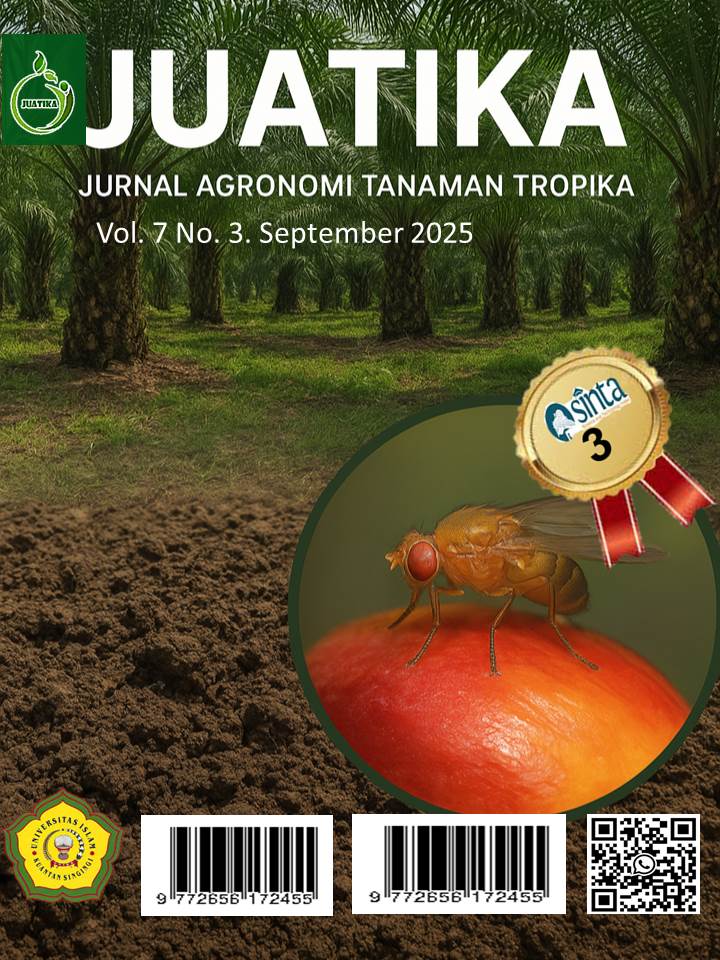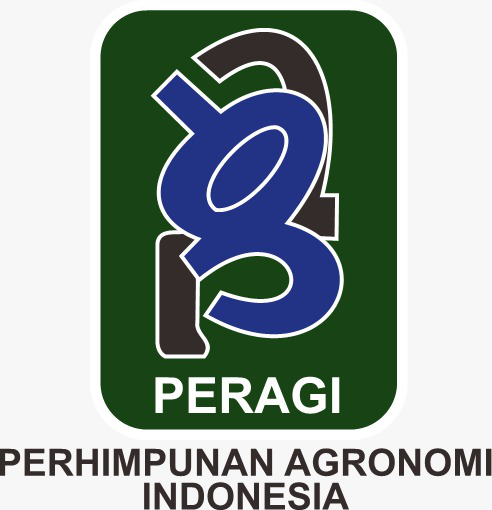Secondary Metabolite Content and Antioxidant Activity of Ethanol Extract of Tali Putri (Cuscuta australis) at Different Heights Places
Abstract
Cuscuta australis (commonly known as Tali Putri) is a parasitic weed that extracts water, minerals, and nutrients from its host plants to sustain its life cycle. Among its shared hosts, Asystasia gangetica (Israel grass) is highly susceptible due to its soft stem structure, which facilitates haustorial penetration and efficient nutrient transfer. Although generally regarded as a harmful weed, C. australis has demonstrated pharmacological potential owing to its secondary metabolites and antioxidant properties, both of which are relevant in disease treatment. This study investigated the effect of altitude on the phytochemical profile, antioxidant activity, moisture content, and ash content of C. australis and its host plant. A survey method was applied across three altitudinal zones (lowland, midland, and highland) with seven replications per site. Laboratory analyses were performed at the Plant Physiology Laboratory, Faculty of Agriculture, Andalas University, and the Higher Education Service Institution (LLDIKTI) Laboratory. Data were analyzed using analysis of variance (ANOVA) with the F-test, and significant differences (p < 0.05) were further evaluated using Duncan's New Multiple Range Test (DNMRT). The results showed that C. australis grown at high altitude exhibited the highest antioxidant activity (173.35 µg/ml), moisture content (9.06%), and ash content (5.16%). Similarly, A. gangetica collected from highland sites demonstrated superior antioxidant activity (64.39 µg/ml), moisture content (8.82%), and ash content (7.07%). By contrast, altitude had no detectable effect on the phytochemical composition of either species, both of which consistently contained flavonoids, alkaloids, phenolics, terpenoids, and triterpenoids. These findings indicate that highland populations of C. australis and A. gangetica possess enhanced bioactive properties, suggesting that high-altitude habitats may provide the most suitable raw material sources for pharmaceutical applications.
Downloads
References
Adli, A. S. (2014). Karakteristik ekstrak etanol tanaman rumput Israel (Asystasia gangetica L.) dari tiga tempat tumbuhan di Indonesia (Skripsi, Issue 1110102000031).
Alhaithloul, H. A. S., Galal, F. H., & Seufi, A. E. M. (2021). Effect of extreme temperature changes on phenolic, flavonoid contents and antioxidant activity of tomato seedlings (Solanum lycopersicum L.). PeerJ, 9, e11193. https://doi.org/10.7717/peerj.11193
Amin, B., Atif, M. J., Meng, H., Ali, M., Li, S., Alharby, H. F., Majrashi, A., Hakeem, K. R., & Cheng, Z. (2022). Melatonin rescues photosynthesis and triggers antioxidant defense response in Cucumis sativus plants challenged by low temperature and high humidity. Frontiers in Plant Science, 13, 855900. https://doi.org/10.3389/fpls.2022.855900
Arnelio, R. (2024). Skrining fitokimia dan uji aktivitas antioksidan ekstrak etanol tali putri (Cuscuta australis R. Br.) pada inang yang berbeda dengan metode DPPH (2,2-diphenyl-1-picrylhydrazyl) (Skripsi, p. 78).
Ballard, C. R., & Maróstica, M. R. (2019). Health benefits of flavonoids. In Bioactive compounds: Health benefits and potential applications (pp. 185–212). Elsevier. https://doi.org/10.1016/B978-0-12-814774-0.00010-4
Caldwell, G. W., Yan, Z., Lang, W., & Masucci, J. A. (2012). The IC50 concept revisited. Current Topics in Medicinal Chemistry, 12(11), 1282–1290. https://doi.org/10.2174/156802612800672844
Chua, I. Y. P., King, P. J. H., Ong, K. H., Sarbini, S. R., & Yiu, P. H. (2015). Influence of light intensity and temperature on antioxidant activity in Premna serratifolia L. Journal of Soil Science and Plant Nutrition, 15(3), 605–614. https://doi.org/10.4067/S0718-95162015005000027
Cyril, A., Esimone, C., Ugwueze, M. E., Anthony, A., & Kanneth, U. O. (2020). In vitro susceptibility of clinical isolates of Candida albicans. World Journal of Pharmacy and Pharmaceutical Sciences, 2(3), 10–18. https://www.cabidigitallibrary.org/doi/full/10.5555/20133257820
Gautam, T., Gautam, S. P., Keservani, R. K., & Sharma, A. K. (2015). Phytochemical screening and wound healing potential of Cuscuta reflexa. Journal of Chinese Pharmaceutical Sciences, 24(5), 292–302. https://doi.org/10.5246/jcps.2015.05.038
Gharibi, S., Tabatabaei, B. E. S., Saeidi, G., & Goli, S. A. H. (2016). Effect of drought stress on total phenolic, lipid peroxidation, and antioxidant activity of Achillea species. Applied Biochemistry and Biotechnology, 178(4), 796–809. https://doi.org/10.1007/s12010-015-1909-3
Giri, I. M. D. S., Wardani, I. G. A. A. K., & Suena, N. M. D. S. (2021). Peran metabolit sekunder tumbuhan dalam pembentukan kolagen pada kulit tikus yang mengalami luka bakar. USADHA: Jurnal Integrasi Obat Tradisional, 1(1), 23–29. https://usadha.unmas.ac.id
Handayani, S., Wirasutisna, K. R., & Insanu, M. (2017). Penapisan fitokimia dan karakterisasi simplisia daun jambu mawar. Jurnal Farmasi UIN Alauddin Makassar, 5(3), 10–16. https://doi.org/10.24252/jfuinam.v5i3.4353
Hidayat, M. A., Fitri, A., & Kuswandi, B. (2017). Scanometry as microplate reader for high throughput method based on DPPH dry reagent for antioxidant assay. Acta Pharmaceutica Sinica B, 7(3), 395–400. https://doi.org/10.1016/j.apsb.2017.02.001
Istiawan, N. D., & Kastono, D. (2019). Pengaruh ketinggian tempat tumbuh terhadap hasil dan kualitas minyak cengkih (Syzygium aromaticum L. Merr. & Perry) di Samigaluh, Kulon Progo. Vegetalika Journal, 8(1), 27–41. https://doi.org/10.22146/veg.35744
Jose, A. G. R., Abirami, T., Kavitha, V., Sellakilli, R., & Karthikeyan, J. (2018). Green synthesis of silver nanoparticles using Asystasia gangetica leaf extract and its antibacterial activity. Journal of Pharmacognosy and Phytochemistry, 7(1), 2453–2457.
Kokla, A., & Melnyk, C. W. (2018). Developing a thief: Haustoria formation in parasitic plants. Developmental Biology, 442(1), 53–59. https://doi.org/10.1016/j.ydbio.2018.06.013
Kurmukov, A. G. (2013). Phytochemistry of medicinal plants. In Medicinal plants of Central Asia: Uzbekistan and Kyrgyzstan (pp. 13–14). Springer. https://doi.org/10.1007/978-1-4614-3912-7_4
Lestari, S., Septiyani, B. N., Proklamasiningsih, E., & Hernayanti, H. (2024). Kandungan flavonoid dan aktivitas antioksidan kitolod (Hippobroma longiflora L.) pada ketinggian tempat tumbuh berbeda. LenteraBio: Berkala Ilmiah Biologi, 13(2), 212–218. https://doi.org/10.26740/lenterab8
Liu, W., Yin, D., Li, N., Hou, X., Wang, D., Li, D., & Liu, J. (2016). Influence of environmental factors on the active substance production and antioxidant activity in Potentilla fruticosa L. and its quality assessment. Scientific Reports, 6, 28591. https://doi.org/10.1038/srep28591
Marrelli, M., Conforti, F., Araniti, F., & Statti, G. A. (2016). Effects of saponins on lipid metabolism: A review of potential health benefits in the treatment of obesity. Molecules, 21(10), 1404. https://doi.org/10.3390/molecules21101404
Maslahah, N., & Nurhayati, H. (2024). Manfaat kesehatan beberapa senyawa fitokimia. Warta BSIP Perkebunan, 2(3), 22–25.
Molyneux, P. (2004). The use of the stable free radical DPPH for estimating antioxidant activity. Songklanakarin Journal of Science and Technology, 26(2), 211–219.
Muharni, S., Muflihah, F., Dasopang, E. S., Naswa, S., & Arianti, N. (2024). Uji aktivitas antihiperlipidemia ekstrak etanol daun ara sungsang (Asystasia gangetica) terhadap kadar kolestrol pada mencit putih jantan (Mus musculus). Indonesian Journal of Pharmaceutical and Clinical Research, 7(2), 41–50. https://doi.org/10.32734/idjpcr.v7i2.18083
Nazirah, S. A., Rosmaina, S., & Rini, S. S. (2023). Flavonoid content and antioxidant activity of ethanolic extract of Pometia pinnata J. R. & G. Forst leaves. Pharmacognosy Journal, 15(1), 216–220. https://doi.org/10.5530/pj.2023.15.26
Nugraheni, N. K. (2020). Potensi senyawa flavonoid dalam menurunkan kadar glukosa darah. Jurnal Ilmiah Kedokteran Wijaya Kusuma, 9(1), 65–72. https://doi.org/10.30742/jikw.v9i1.754
Nurdin, N., Nurdin, A., & Iskandar, Y. (2023). Uji aktivitas antioksidan ekstrak etanol daun Asystasia gangetica (L.) T. Anderson dengan metode DPPH. Jurnal Ilmiah Farmako Bahari, 14(1), 25–32. https://doi.org/10.35316/jfb.v14i1.1831
Panche, A. N., Diwan, A. D., & Chandra, S. R. (2016). Flavonoids: An overview. Journal of Nutritional Science, 5, e47. https://doi.org/10.1017/jns.2016.41
Pietta, P. G. (2000). Flavonoids as antioxidants. Journal of Natural Products, 63(7), 1035–1042. https://doi.org/10.1021/np9904509
Prabowo, A. A., Kurniawan, A., & Fathurrahman, F. (2021). Uji aktivitas antioksidan ekstrak etanol daun tali putri (Cuscuta australis R. Br.) dengan metode DPPH. Jurnal Fitofarmaka Indonesia, 8(1), 1–7. https://doi.org/10.33096/jffi.v8i1.902
Pratiwi, R. (2018). Fitokimia: Senyawa flavonoid dan manfaatnya bagi kesehatan. Jurnal Farmasi Sains dan Praktis, 4(2), 25–32.
Putri, R. N. (2017). Efek antioksidan dari senyawa flavonoid dalam buah-buahan. Jurnal Gizi dan Kesehatan, 9(2), 101–109.
Rijai, L. (2018). Kandungan flavonoid dan aktivitas antioksidan ekstrak etanol daun Asystasia gangetica. Pharmacon, 7(3), 79–86. https://doi.org/10.35799/pha.7.2018.21082
Sari, N. M., Handayani, S., & Nurhayati, N. (2020). Penapisan fitokimia dan uji aktivitas antioksidan ekstrak etanol daun tali putri (Cuscuta australis R. Br.). Jurnal Farmasi Galenika, 6(1), 59–65. https://doi.org/10.22487/j24428744.2020.v6.i1.14297
Sari, P., & Wulandari, D. (2022). Uji aktivitas antioksidan ekstrak etanol daun Pometia pinnata dengan metode DPPH. Jurnal Farmasi dan Kesehatan, 12(1), 44–50. https://doi.org/10.33096/jfk.v12i1.2516
Septiana, R., Handayani, S., & Nurhayati, N. (2020). Uji aktivitas antioksidan ekstrak etanol daun tali putri (Cuscuta australis R. Br.) dengan metode DPPH. Indonesian Journal of Pharmacy and Natural Product, 3(2), 57–62. https://doi.org/10.33096/ijpnp.v3i2.671
Shahidi, F., & Ambigaipalan, P. (2015). Phenolics and polyphenolics in foods, beverages and spices: Antioxidant activity and health effects – A review. Journal of Functional Foods, 18, 820–897. https://doi.org/10.1016/j.jff.2015.06.018
Silalahi, J. (2006). Senyawa bioaktif dalam makanan: Suatu kajian kimia pangan. Pustaka Pelajar.
Srinivasan, R., Chandrasekar, M. J. N., Nanjan, M. J., & Suresh, B. (2007). Antioxidant activity of Caesalpinia digyna root. Journal of Ethnopharmacology, 113(2), 284–291. https://doi.org/10.1016/j.jep.2007.06.013
Subramanian, S., & Nandhini, M. (2014). Preliminary phytochemical screening and antioxidant activity of Asystasia gangetica. International Journal of Pharmacy and Pharmaceutical Sciences, 6(5), 539–543.
Wang, T., Li, Q., Bi, K., & Xu, L. (2018). Flavonoids and antioxidant activity of Asystasia gangetica leaves. Natural Product Research, 32(14), 1685–1689. https://doi.org/10.1080/14786419.2017.1350668
Wibowo, A., & Susilo, H. (2019). Uji aktivitas antioksidan ekstrak etanol daun tali putri (Cuscuta australis R. Br.) dengan metode DPPH. Jurnal Farmasi Udayana, 8(2), 134–142. https://doi.org/10.24843/jfu.2019.v08.i02.p09
Yanti, Y., & Mariani, R. (2021). Aktivitas antioksidan ekstrak etanol daun Asystasia gangetica (L.) T. Anderson dengan metode DPPH. Jurnal Farmasi dan Kesehatan, 11(1), 1–7. https://doi.org/10.33096/jfk.v11i1.1958
Yuliani, N., & Hartati, H. (2020). Uji aktivitas antioksidan ekstrak etanol daun tali putri (Cuscuta australis R. Br.) dengan metode DPPH. Jurnal Fitofarmaka Indonesia, 6(2), 45–51. https://doi.org/10.33096/jffi.v6i2.482
Yuniarti, E., Nurhayati, N., & Handayani, S. (2020). Uji aktivitas antioksidan ekstrak etanol daun tali putri (Cuscuta australis R. Br.) dengan metode DPPH. Jurnal Farmasi Galenika, 6(2), 105–111. https://doi.org/10.22487/j24428744.2020.v6.i2.15020
Copyright (c) 2025 Rangga Arnelio, Aprizal Zainal, Benni Satria

This work is licensed under a Creative Commons Attribution 4.0 International License.
Authors who publish with Jurnal Agronomi Tanaman Tropika (JUATIKA) agree to the following terms:
Authors retain copyright and grant the Jurnal Agronomi Tanaman Tropika (JUATIKA) right of first publication with the work simultaneously licensed under a Creative Commons Attribution License (CC BY 4.0) that allows others to share (copy and redistribute the material in any medium or format) and adapt (remix, transform, and build upon the material for any purpose, even commercially) with an acknowledgment of the work's authorship and initial publication in Jurnal Agronomi Tanaman Tropika (JUATIKA).
Authors are able to enter into separate, additional contractual arrangements for the non-exclusive distribution of the journal's published version of the work (e.g., post it to an institutional repository or publish it in a book), with an acknowledgment of its initial publication in Jurnal Agronomi Tanaman Tropika (JUATIKA). Authors are permitted and encouraged to post their work online (e.g., in institutional repositories or on their website) prior to and during the submission process, as it can lead to productive exchanges, as well as earlier and greater citation of published work.







 More Information
More Information



